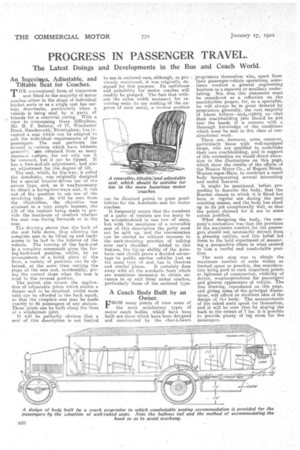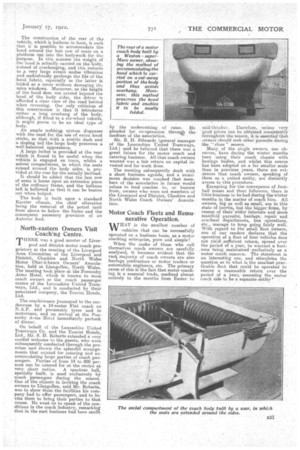PROGRESS IN PASSENGER TRAVEL
Page 20

Page 21

If you've noticed an error in this article please click here to report it so we can fix it.
The Latest Doings and Developments in the Bus and Coach World.
An Ingenious, Adjustable, and Tiltable Seat for Coaches.
THE conventional form of transverse seat fitted to the majority of motor coaches either in the shape of individual bucket seats or as a single seat has certain drawbacks, particularly when a vehicle is being used by a party of friends for a convivial outing. With a view to overcoming these difficulties,
Mr. H. Belieny, of 17, Winchester Road, Randswortialiirmingham, has ira veoted a seat which can be adapted' to suit the individual requirements of the passengers. The seat performs the eeveral op-rations which have hitherto generery '4en obtained from as many separtoe c.esigns, for not only can it be reversed, but it can be tipped. It has a fore-and-aft adjustment, and also an adjustment for the degree of tilt.
The seat, which, by the, way, is called the Autobatic, was originally designed for a special interior-driven car of the saloon type, and, as it wasnecessary to obtain a facing-two-ways seat, it was out of the, question to use -one of the revolving type. As will he seen from the illustration, the objective was attained, in a very simple manner, the tilt of the cushion being made to provide the maximum of comfort whether the seat was facing forwards or to the rear.
The drawing shows that the back of the seat falls down, thus allowing the complete seat to be lifted up and ready access to be had to the interior of the vehicle. The turning of the back-rest in a complete somersault gives the facing-backward position, whilst, by an arrangement of a holed plate in the floor, a variety of positions can be obtained, at the same time varying the slope of the seat and, incidentally, giving the correct slope when the seat is used in the reverse position. The patent, also covers the application of adjustable joints which enable a deeper seat to be obtained: whilst more rake can be afforded to the back squab, so that the complete seat may be made exactly to fit passengers of any stature. These joints can be built along the lines of a windscreen joint.
It will be perfectly obvious that a seat of this description is not limited
to use in enclosed cars, although, as previously mentioned, it was originally designed for this purpose. Its usefulness and suitability for -motor coaches will readily be grasped. The fact that without the extra width necessary for revolving seats (to say nothing of the expense of such seats), a reverse position
can be cibtained points to great possibilities for the Autobatic seat for motor coaches.
It frequently occurs that the members of a party of tourists are too many to be accommodated in one row of seats, but with the assistance of a reversible seat of this description the party need not be split up, and the conversation can be carried on without recourse to the neck-straining practice of talking over one's shoulder. Added to this feature, the tip-up ability of the Autobatic seat should prove a decided advantageto public service vehicles just as the same type of seat has in theatres and similar places. It certainly does away with all the acrobatic feats which are sometimes necessary to obtain entrance to of exit from motor coaches, particularly those of the enclosed type.
A Coach Body Built by an Owner. pROM many points of view some of
the most satisfactory types of motor coach bodies which have been built are those which have been designed and constructed by the char-a-bancs
_proprietors themselves who, apart from their passenger-vehicle operations, sometimes conduct a. general engineering; business as a separate or auxiliary undertaking. Not that, this statement must be considered as a reflection on the coachbuilder proper, for, as a specialist, he will always be in great demand by proprietors generally, the vast majority of whom believe—andarightly so—that their coachbuilding jsbs should be put into the hands Of a concern with a thorough knowledge of the conditions which must be met in this class of constructional work.
There are, -however, some concerns, particularly those with well-equipped shops, who are qualified to undertake their own coaehbuilding, and in support. of this contention we Would direct attention to the illustrations on this page, which show th-e results of the efforts of the Weston Motor Co., of Regent Street., Weston-super-Mare, to construct a coach body incorporating several interesting and useful features.
It might be mentioned, before proceeding to describe the body, that the Xarrier chassis to which it is fitted has been in regular use during the past (teaching season, and the body has stood up to its job exceptionally well, so that the points claimed for it are to some extent justified.
When designing the body, the company's contention was that the provision of the maximum comfort for the passengers should notnecessarily detract from a. pleasing outline, and this belief led them to the bad experiment of measuring a prospective cheat in what seemed to him a restful and comfortable posi
tioTilhe next step was to obtain the maximum number of seats within as limited space as possible, due consideration being paid to such important points as lightness of construction, visibility of driver, weatherproofness for passengers and general appearance of vehicle. The line drawing, reproduced on this page, and giving some of the principal dimensions, will afford an excellent idea of the design of tha body.' The measurements of the raked seats speak for themselves, and it will be seen that by sloping the back to the extent of 7 ins, it. is possible to provide plenty of leg room for the passengers.
The construction of the rear of the vehicle, which is bulbous in form, is such that it is possible to accommodate the hood around the last row of seats on a platform cut into the bodywork for the purpose. In this manner the weight of the hood is actually carried on the body, instead of overhanging, and this reduces to A very large extent undue vibration and undoubtedly prolongs the life of the hood fabric, especially as the latter is folded as a cover without damaging the mica windows. Moreover, as the height of the hood, does not extend beyond the level of the body sides, the driver is afforded a clear view of the road behind when reversing. Our only criticism of this construction is that it introduces rather a long overhang of the body, although, if fitted to a six-wheel vehicle, it might. prove to be an ideal type of body. An ample webbin,g system dispenses with the need for the use of extra. hood sticks, so that with a scuttle dash and a sloping tail the large body possesses a well-balanced appearance. A large locker is provided at the rear which is found to be useful when the vehicle is engaged on tours, whilst a saloon compartment, in which the seats extend around the body sides, is providod at the rear for the socially inclined. It should be added that the last row of seats is borne upon an extension piece of the ordinary frame, and the bulbous tail is hollowed so that it can be beaten out when bulged. The body is built upon a standard Karrier chassis, the chief alteration being the removal of the petrol tank from above to belowthe frame and the consequent necessary provision of an Autovac feed.
North-eastern Owners Visit Coach'ng Centre.
THERE was a good muster of Liverpool and district motor coach proprietors at the meeting of the Liverpool Area Committee of the Liverpool and District, Cheshire and North Wales Motor Char-a-bancs Owners' Association, held at Llangollen, North Wales. The meeting took place at the Ponsonby Arms Hotel, which is known to most coach owners as the coach passenger centre of the Lancashire United Tramways, Ltd., and is conducted by their associated company, the Tourist Hotels, Ltd.
The coachowners journeyed to the rendezvous by a 14-seater Fiat coach on N.A.P. and pneumatic tyres and in motorcars, and on arrival at the Ponsonby Arms Hotel immediately partook of dinner.
On behalf of the Lancashire United Tramways Co. and the Tourist Hotels, Ltd., Mr. S. H. Roberts extended a very cordial welcome to the guests, who were subsequently conducted through the premises and shown the splendid arrangements that existed for catering and accommodating large parties of coach passengers. Parties of from 14 to 800 persons can be catered for at the centre at very short notice. A spacious hall, specially built, is used exclusively by coach passengers during the season. One of the objects in inviting the coach owners to Llangollen, said Mr. Roberts, was to show them the facilities his company had to offer passengers, and to invite them to bring their parties to that venue. He went on to speak of the conditions in the coach industry, remarking that in the past business had been spoilt




























